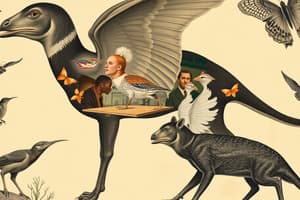Podcast
Questions and Answers
Which scenario represents a study in the field of animal ecology?
Which scenario represents a study in the field of animal ecology?
- Examining the bone structure of fossils of extinct mammal species to infer their evolutionary relationships.
- Analyzing the effect of habitat fragmentation on the population size of a particular bird species. (correct)
- Developing new vaccines for livestock to prevent the spread of viral diseases.
- Investigating the genetic mutations in a population of fruit flies over several generations.
Which action is most directly aligned with the principles of conservation biology?
Which action is most directly aligned with the principles of conservation biology?
- Creating a research protocol for a new veterinary surgical technique.
- Studying the predator-prey relationships within a specific region.
- Implementing a program to relocate an endangered species from a highly developed area to a protected habitat. (correct)
- Analyzing the nutritional needs of domestic cats in a shelter environment.
A researcher is developing a phylogenetic tree for several species of reptiles. Which aspect of evolutionary biology is primarily reflected in the creation of this tree?
A researcher is developing a phylogenetic tree for several species of reptiles. Which aspect of evolutionary biology is primarily reflected in the creation of this tree?
- The analysis of ancient animal forms through fossil records.
- The mapping of evolutionary relationships to understand common ancestry and divergent adaptations. (correct)
- The study of animal population dynamics based on current ecological relationships.
- The development of best practices for care and environment of reptiles in captivity.
Which aspect is a primary concern of animal welfare?
Which aspect is a primary concern of animal welfare?
Which example best indicates the application of zoological knowledge towards applied zoology?
Which example best indicates the application of zoological knowledge towards applied zoology?
Which of the following best explains the purpose of the Linnaean system in zoology?
Which of the following best explains the purpose of the Linnaean system in zoology?
Which characteristic is LEAST important when classifying animals under the Linnaean system?
Which characteristic is LEAST important when classifying animals under the Linnaean system?
Which physiological system is responsible for breaking down food into absorbable nutrients?
Which physiological system is responsible for breaking down food into absorbable nutrients?
During the observation of a new animal species, what would be the most relevant factor to determine its behavioral pattern?
During the observation of a new animal species, what would be the most relevant factor to determine its behavioral pattern?
In the study of animal diversity, which aspect is most crucial in understanding the evolutionary adaptation of a species?
In the study of animal diversity, which aspect is most crucial in understanding the evolutionary adaptation of a species?
Which animal phylum is characterized by radial symmetry, tissue layers, and contain cnidocytes?
Which animal phylum is characterized by radial symmetry, tissue layers, and contain cnidocytes?
Which of the following terms best describe behavior that animals are born with, rather than learned?
Which of the following terms best describe behavior that animals are born with, rather than learned?
Which of these would be a primary focus of study in animal physiology?
Which of these would be a primary focus of study in animal physiology?
Flashcards
What is Zoology?
What is Zoology?
The branch of biology that focuses on the scientific study of animals.
What is the Linnaean system?
What is the Linnaean system?
A system of classifying organisms into hierarchical groups based on shared characteristics.
What is Animal Diversity?
What is Animal Diversity?
The diverse array of animal species, forms, adaptations, and their evolutionary relationships.
What is Animal Physiology?
What is Animal Physiology?
Signup and view all the flashcards
What is Animal Behavior?
What is Animal Behavior?
Signup and view all the flashcards
What is Innate Behavior?
What is Innate Behavior?
Signup and view all the flashcards
What is Learned Behavior?
What is Learned Behavior?
Signup and view all the flashcards
What is Adaptation?
What is Adaptation?
Signup and view all the flashcards
Animal Ecology
Animal Ecology
Signup and view all the flashcards
Natural Selection
Natural Selection
Signup and view all the flashcards
Phylogenetic Tree
Phylogenetic Tree
Signup and view all the flashcards
Conservation Biology
Conservation Biology
Signup and view all the flashcards
Animal Welfare
Animal Welfare
Signup and view all the flashcards
Study Notes
Introduction to Zoology
- Zoology is the biological study of animals, encompassing diverse topics.
- Key areas include animal behavior, physiology, anatomy, evolution, and ecology.
- Zoologists investigate various species, from microscopic invertebrates to large mammals.
- Applications range from conservation to human health.
Animal Classification
- Animals are grouped by shared characteristics (observable traits and genetics).
- The Linnaean system (Kingdom, Phylum, Class, Order, Family, Genus, Species) reflects evolutionary relationships.
- Classification considers body symmetry, tissues, body cavities, and segmentation.
Animal Diversity
- Animal diversity includes a vast array of forms, sizes, and environmentally-adapted species.
- Major phyla include Porifera, Cnidaria, Platyhelminthes, Annelida, Mollusca, Arthropoda, Echinodermata, and Chordata.
- Phyla display unique, evolved adaptations for various habitats.
Animal Physiology
- Animal physiology explores the functions of organs and organ systems.
- Key systems include digestive, circulatory, respiratory, excretory, nervous, endocrine, and immune systems.
- Physiological processes differ among groups due to evolutionary pressures and environmental needs.
- This includes metabolism, sensory perception, and responses to stimuli.
Animal Behavior
- Animal behavior involves observable actions and responses to the environment.
- Behavioral patterns can be inherent or learned.
- Influencing factors include genetics, experience, and the environment.
- Crucial aspects studied include communication, social interactions, courtship, foraging, and migration.
Animal Ecology
- Animal ecology investigates the relationships between animals and their surroundings.
- Key concepts are population dynamics, community interactions, and ecosystem roles.
- Competition, predation, and symbiosis are significant community interactions.
- Animals maintain ecosystem balance through nutrient cycling, pollination, etc.
Evolutionary Biology
- Zoology examines animal evolution, including natural selection, adaptations, and origins of animal groups.
- Phylogenetic trees visualize species relationships, outlining common ancestry and adaptations.
- Fossils offer insights into ancient animal forms.
Conservation Biology
- Conservation biology uses zoological principles to protect endangered species and biodiversity.
- Conservation efforts involve habitat protection, species reintroduction, and controlling invasive species.
- Understanding animal behavior and ecology is essential for effective conservation.
Animal Welfare
- Animal welfare considers the well-being of captive and wild animals.
- Ethical considerations govern animal research and management.
- Proper care, nutrition, and environment improve animal health.
Applied Zoology
- Applied zoology applies zoological knowledge practically.
- Branches include veterinary medicine, animal husbandry, and agriculture.
- Public health relies on vector biology for disease prevention and control.
Studying That Suits You
Use AI to generate personalized quizzes and flashcards to suit your learning preferences.




